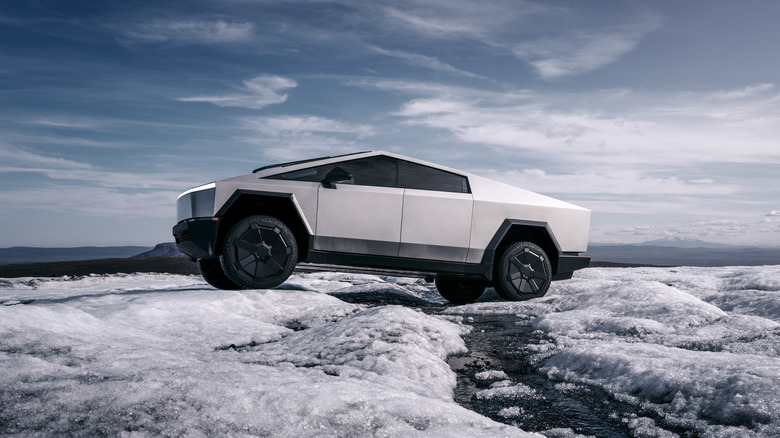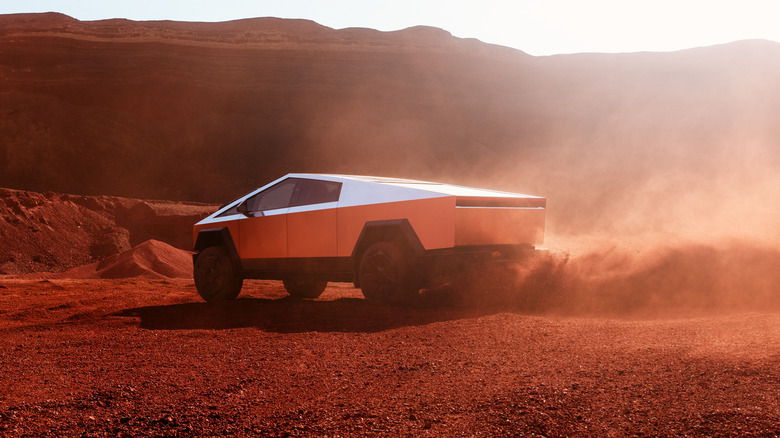Breaking Down The Cybertruck: Complete Analysis Of Stats And Features, As Told By Elon Musk
The Tesla Cybertruck has presumably just started deliveries, and at least according to Elon Musk, it's the company's "best" product. Over the course of the presentation, Elon extolled the virtues of the Cybertruck, and it sure is something. As a truck, Musk said, "It's basically a very useful truck," which should be the bare minimum that any truck should aspire to, much less a truck that's been in development as long as the Tesla has.
From a specification standpoint, once again, this is all coming directly from Elon Musk's mouth; the truck has an 11,000 pounds towing capacity and a 2,500 pounds payload capacity. For comparison, the Ford F-150 Lightning, a truck that actually exists in a significant quantity, can tow upwards of 10,000 pounds with the Max Trailer Tow Package, and the maximum payload of the standard range model tops out at 2,235 pounds. The diesel-powered Ford Super Duty can be outfitted to tow 40,000 pounds and have a payload of 8,000 pounds.
Elon also bragged of the Cybertruck's ability to haul a 4-foot by 8-foot sheet of plywood (with the tailgate down), something that pickup trucks have been accomplishing without difficulty since the advent of standardized building materials. Stylistically, the Cybertruck is breaking new ground (for good or ill). As a truck, it's still quite a ways behind.
How fast is it?
The Cybertruck has a listed curb weight, meaning the total weight without occupants, is 6,850 pounds. The aforementioned Ford F-150 Lightning clocks in at a minimum of 6,015 pounds for the base model and 6,893 pounds for the Platinum trim.
For actual driving specifications, Elon said that the Cybertruck is capable of accelerating to 60 miles per hour in 2.6 seconds. Which, if accurate, would make it the fastest-accelerating production pickup in the world. The F-150 Lightning Lariat is capable of a 3.8 second 0-60 time, and the Quad-Motor Rivian R1T accomplishes the feat in 3.0 seconds flat. Musk stated, "It doesn't feel like a normal truck; it's smooth as silk and silent when you drive it." Without reading a decibel meter, those claims are impossible to verify. It's also equipped with adaptive air suspension, a feature luxury cars have had for several years.
The truck is stated to have a "true" 17-inch ground clearance and a flat bottom for maximum off-roadness. The GMC Hummer SUV can lift itself to 16 inches. It has a listed drag coefficient of .335cd. For comparison, the Hyundai Ioniq 6 has a drag coefficient of 0.21cd. Lower is better.
New, but not really
On the technical end, it reportedly sports locking differentials, a feature that has been present on trucks and off-road vehicles for a number of decades. Plus, it has rear torque vectoring (i.e., the ability to shift torque around to either wheel). It's a relatively new feature to EVs, but according to Car and Driver, it's been around in gas-powered cars since at least the Mitsubishi Lancer Evolution. Four-wheel steering is another listed feature on the Cybertruck. In the EV world, that feature was a huge selling point of the GMC Hummer. In the gas-powered world, cars like the Honda Prelude came equipped with the ability in the late 1980s. Elon seemed very excited to announce that it used a 48-volt electrical system. 48-volt systems are widely used in hybrid and mild hybrid vehicles like the Ram 1500 pickup with eTorque.
The Cybertruck has a lot of wild advertised features that aren't really that special in the long span of automotive history. As a battery-powered truck, it's ever so slightly better in capability than its competitors at Ford or Rivian. However, it's hopeless against gas-powered trucks anywhere it actually matters, like payload and towing capacity. It seems to be genuinely fast on the surface, but that's not exactly an in-demand feature for towing or hauling when protecting your cargo, and carefulness is more important than laying down rubber.


